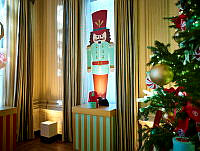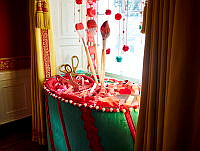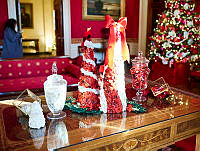Grace Coolidge

Grace Anna Goodhue was born on January 3, 1879, in Burlington, Vermont. She was the only child of Andrew and Lemira Goodhue. Following her graduation from Burlington High School in 1897, Grace attended the University of Vermont, and joined the women’s fraternity Pi Beta Phi. Following her graduation in 1902, Grace entered training at the Clarke School for the Deaf in Northampton, Massachusetts. She continued to teach children at the school until 1905.1
While living in Northampton, Grace met a lawyer named Calvin Coolidge, and the pair married on October 4, 1905. She gave birth to two children, John in 1906 and Calvin Jr. in 1908. Grace supported her husband’s emerging career in local and state politics. While he served as lieutenant governor and governor of Massachusetts, Grace operated their family home in Northampton raising her sons and traveled regularly to join him in Boston. When Coolidge began serving as vice president under President Warren G. Harding in 1921, Grace settled into a suite at the Willard Hotel in Washington, D.C. As the wife of the vice president, she found herself in charge of the Ladies of the Senate volunteer organization and began hosting luncheons, teas, and charity events.2
Following the death of President Harding on August 2, 1923, Calvin Coolidge became president and they moved into the White House on August 21. Grace recorded her thoughts on the monumental moment in her autobiography:
“There was a sense of detachment—this was I and not yet I, this was the wife of the President of the United States and she took precedence over me; my personal likes and dislikes must be subordinated to the consideration of those things which were required of her.”3
Although Grace felt the weight of her role and understood the increased public attention on the first lady in the press, she rose to the challenge. As first lady, she demonstrated an appreciation for pop culture and sports, attending baseball games and inviting celebrities to the White House. She was also well liked by Washington, D.C. society and was known for her hospitality and entertaining. On one memorable occasion, Grace hosted the 1927 White House Easter Egg Roll along with her pet, a racoon named Rebecca.4
Grace Coolidge also suffered tragedy at the White House. In 1924, Calvin Coolidge, Jr. developed a blister on his toe after playing tennis on the White House tennis court. The injury soon became serious and on July 7, 1924, he died from septicemia and his funeral occurred several days later in the East Room.5
Following her son’s death, Grace began working to improve the White House. She decorated the family quarters in a colonial style and worked to return historic furnishings previously removed from the White House. To accomplish these goals, in 1925 Congress passed a joint resolution allowing the White House to accept donations of art and furniture. Grace also worked with an advisory committee to acquire antiques and other American historical furnishings.6
In 1929, the Coolidges left the White House and retired to Northampton. Calvin Coolidge died on January 5, 1933, of a heart attack. Following his death, Grace continued her lifelong advocacy for the deaf and those hard of hearing, serving on the board and later as board president for her former employer, the Clarke School for the Deaf. She also remained an active community member in Northampton, volunteered, supported charities, and traveled in Europe. She passed away on July 8, 1957, at the age of seventy-eight.7
Footnotes & Resources
- Grace Coolidge, Grace Coolidge An Autobiography, ed. Lawrence E. Wikander and Robert H. Ferrell (Plymouth, Vermont: Calvin Coolidge Memorial Foundation, Inc., 1992), 26-30; Robert H. Ferrell, Grace Coolidge: The People’s Lady in Silent Cal’s White House, (Lawrence, Kansas: University Press of Kansas, 2008, 18-19.
- Coolidge, Grace Coolidge an Autobiography, 38-40, 51, 54-59; Ferrell, Grace Coolidge, 48-50.
- Coolidge, Grace Coolidge an Autobiography, 62-63; Ferrell, Grace Coolidge, 57.
- Grace Coolidge, The Miller Center, Accessed September 30, 2022, https://millercenter.org/president/coolidge/essays/coolidge-1923-firstlady; “Mrs. Coolidge Shows Rebecca to Children,” The White House Historical Association, April 18, 1927, https://library.whitehousehistory.org/fotoweb/archives/5017-Digital-Library/Main%20Index/Presidents/Calvin%20Coolidge/1165.tif.info#c=%2Ffotoweb%2Farchives%2F5017-Digital-Library%2F%3Fq%3Drebecca%2520raccoon.
- William Seale, The President’s House, (Washington, D.C.: The White House Historical Association, 2008), 116-117; Jared Rhoads, “The Medical Context of Calvin Jr.’s Untimely Death,” The Coolidge Foundation, July 7, 2014, https://coolidgefoundation.org/blog/the-medical-context-of-calvin-jr-s-untimely-death/.
- Seale, The President’s House, 118-125.
- Coolidge, Grace Coolidge An Autobiography, 109-115.






























































